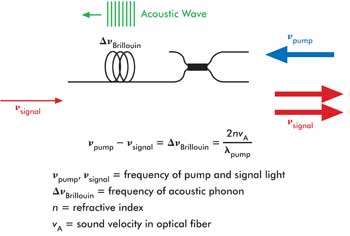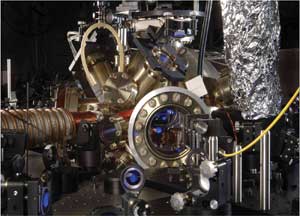
Sound helps make a better optical clock
Optical fibers are commonly used to transmit information and data
via modulated light pulses. Now, however, three researchers at Physikalisch-Technische
Bundesanstalt (PTB), working with optical frequencies rather than voice or data,
are seeking to build a better optical clock.
As signals travel along optical fibers, they become weaker because
of optical attenuation and must be amplified. This presents a problem because the
demand for extreme precision in transmitting the optical frequency cannot be met
with conventional optical amplifiers.
The investigators report that they have found an elegant solution:
fiber Brillouin amplification, a technique closely related to stimulated Brillouin
scattering. Their method includes injecting pump light with a well-defined frequency
into the far end of the glass fiber so that it travels in the opposite direction
of the signal light, thus generating sound waves (acoustic phonons).

Shown is Brillouin amplification in an optical fiber.
The sound waves then scatter the pump light, enabling the existing
signal photons to stimulate the emission of many more signal photons. Thus, a photon
avalanche is created – and kept going by the sound waves – bringing
the frequency information to the remote end of the optical fiber with extremely
small losses and very high precision.
480-km optical fiber used
The researchers demonstrated their technique on a 480-km optical
fiber link: The relative measurement uncertainty they achieved is equivalent to
a deviation of 1 s in 16 billion years. The method simplifies the comparison of
newly developed optical clocks, which possess such high frequency stability that
traditional methods for frequency and time comparison via satellite are no longer
sufficient.
The technique is likely to have applications in other areas where
precise synchronization is needed; for example, in radio astronomy. Experts in geodesy
have approached the researchers with suggestions for joint projects.
PTB investigators Harald Schnatz and Gesine Grosche use the optical
frequency of the light, with some 195 x 1012 cycles per second, as the information
transmitted. A first application of this method was the remote measurement, conducted
last year, of the so-called optical clock transition in a magnesium clock at Leibniz
University Hannover.
The scientists determined the characteristic frequency with which
very cold magnesium atoms can be excited to a particularly long-lived state, by
a measurement from PTB via a 73-km optical fiber. According to the researchers,
it is important to measure such frequencies accurately because, in principle, they
can be used to “generate” seconds.

This setup is of an optical lattice clock with strontium atoms.
“For such measurements, there are femtosecond frequency
comb generators at both ends which produce a fixed phase relationship between the
transmitted light and the frequency standards on site,” Schnatz said. The
on-site frequency standards are the new magnesium clock in Hannover and an optical
clock at PTB, both operated within the Centre for Quantum Engineering and Space-Time
Research. The different frequencies of the two are compared with the aid of the
frequency comb generators, which can be thought of as a gear mechanism. “At
first we were astonished at how well this complete system works,” Schnatz
said.
Then the researchers wanted to bridge larger distances and build
a connection for joint experiments to Max-Planck Institute for Quantum Optics in
Garching – a link of 900-km fiber that attenuates the light by the almost
inconceivable factor of 1020 if not amplified. Moreover, the fiber had to be passed
through twice because it is part of a huge interferometer. This is how the optical
length of the entire link, which otherwise varies because of temperature fluctuations,
is stabilized. At this point, conventional amplification techniques reach their
limits.
“Our PhD student, Osama Terra, hit on the brilliant idea
of using the Brillouin amplification in the fiber itself,” Grosche said. “This
gives us several advantages at the same time: First, even very weak signals are
still amplified; the signal power is multiplied by a factor of up to 1 million.
Thus, we need considerably fewer amplifier stations. Moreover, it is possible to
selectively amplify very narrowband light signals.”
The investigators tested this concept on a deployed underground
fiber link in cooperation with the German National Research and Education Network
(Deutsches Forschungsnetz) and GasLine GmbH & Co. KG, which together operate
a German-wide fiber network. With only one intermediate amplification station, the
ultrastable frequency was transmitted over the 480-km-long fiber link that had a
relative transmission uncertainty of only two parts in 1018. Their work was reported
in the July 2010 issue of Optics Express.
As a result, even a connection with PTB’s partner institute
in Paris, Observatoire de Paris/Systèmes de Référence Temps-Espace,
now looks realistic – with a vision of working together on the best optical
clocks.
Published: September 2010